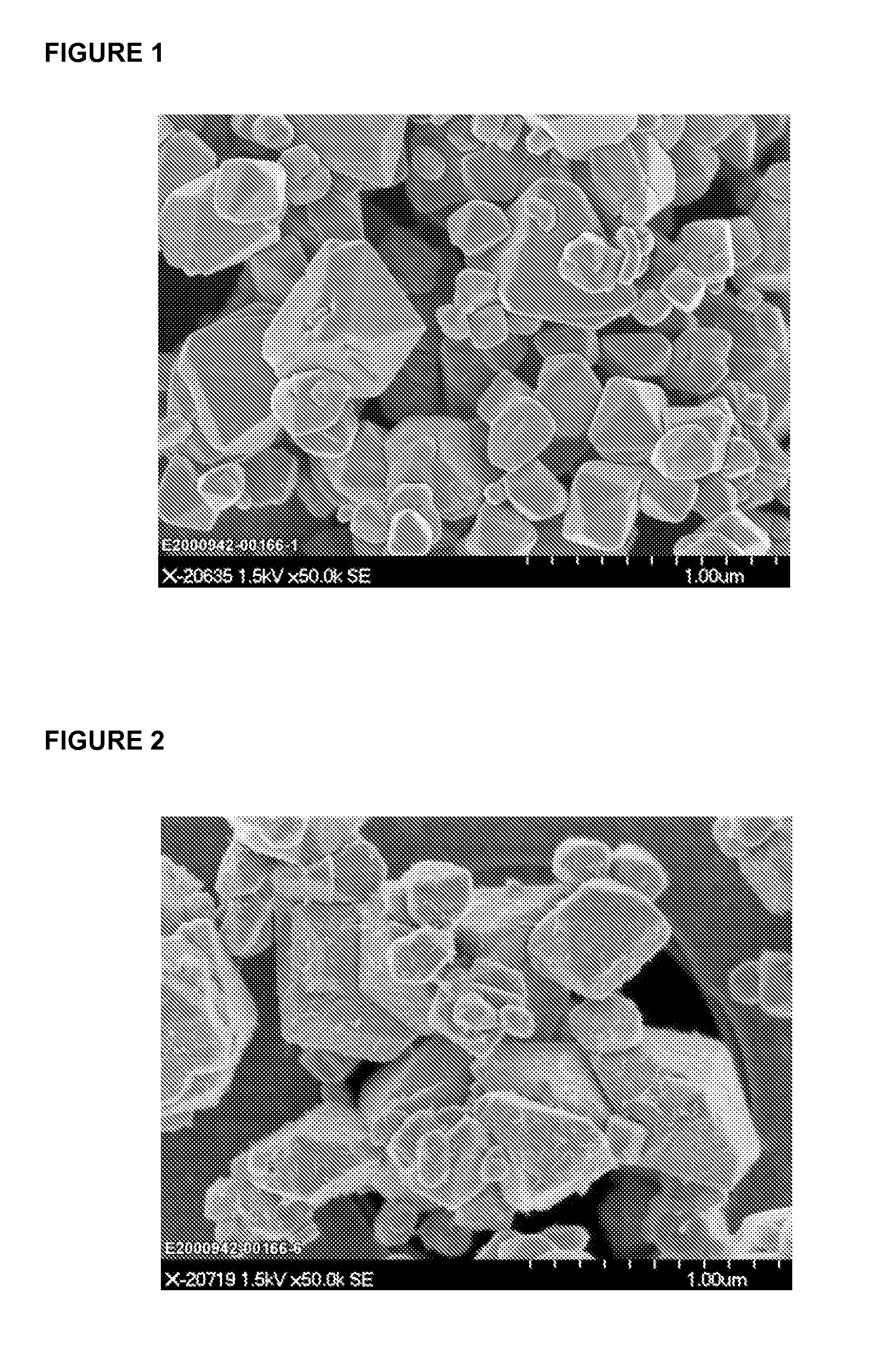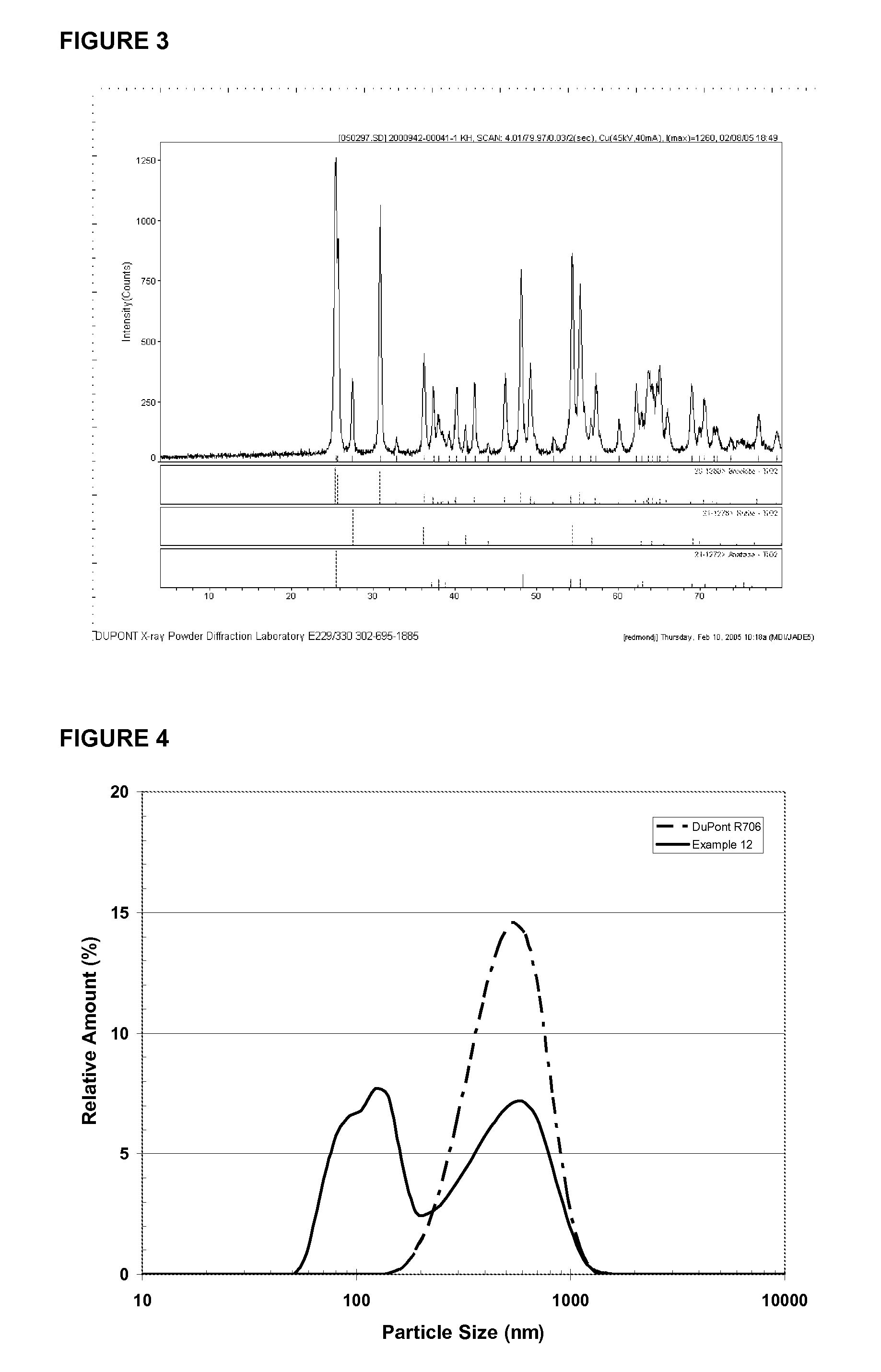Processes for the hydrothermal production of titanuim dioxide
a technology of titanuim dioxide and hydrothermal production, which is applied in the direction of titanium dioxide, pigmenting treatment, material nanotechnology, etc., can solve the problems of pigmentary-sized or nano-sized rutil
- Summary
- Abstract
- Description
- Claims
- Application Information
AI Technical Summary
Benefits of technology
Problems solved by technology
Method used
Image
Examples
example 1
[0039]Preparation of a Titanyl Hydroxide Precipitate from Reagent Grade Ammonium Titanyl Oxalate
[0040]A mixture containing 150 g of a reagent grade ammonium titanyl oxalate monohydrate (Acros; CAS#10580-03-7) and 1200 g of deionized water was added to a 4 L glass beaker. The mixture was agitated by a magnetic stir bar for 30 minutes at room temperature and filtered via a 0.45 μm disposable nylon filter cup to remove any insoluble impurities. The filtrate was collected and transferred back into the 4 L glass beaker and heated to 80° C. on a hot plate with constant agitation. Concentrated NH4OH (28-30 wt % NH3; CAS#1336-21-6) was gradually added to titrate the ammonium titanyl oxalate solution to pH 8.0-8.3, while the temperature of the mixture was maintained at 80° C. The reaction mixture was kept at temperature for an additional 15 minutes and then filtered via a 24 cm #54 Whatman paper filter to yield 463 g of titanyl hydroxide precipitate. The titanyl hydroxide precipitate was col...
example 2
[0041]Hydrothermal Crystallization of Nano-Size Rutile TiO2 from Reagent Grade Ammonium Titanyl Oxalate Derived Titanyl Hydroxide Precipitate
[0042]A mixture consisting of 4 g of a reagent grade ammonium titanyl oxalate derived titanyl hydroxide precipitate (refer to Example 1 for precipitate preparation and characterization), 0.0102 g of ZnCl2 (reagent grade, CAS# 7646-85-7), and 3.9 g of a dilute HCl solution was diluted with deionized water to a concentration of 4 grams of TiO2 per 100 grams of slurry. The dilute HCl solution was prepared by combining 2.8 g of a 12.1N reagent grade HCl solution (CAS# 7647-01-0) and 32.6 g of deionized water. The mixture containing the titanium precipitate was added to a 10 mL gold tube with a welded bottom. The top of the gold tube was then crimped, and the tube was inserted vertically into a 1 L Zr-702 pressure vessel. To facilitate heat transfer inside the 1 L reactor, water was added to submerge the bottom half of the inserted gold tube. The re...
example 3
[0043]Hydrothermal Crystallization of Pigmentary Rutile TiO2 at 250° C. from Reagent Grade Ammonium Titanyl Oxalate Derived Titanyl Hydroxide Precipitate (10 mL Scale)
[0044]A mixture consisting of 4 g of a reagent grade ammonium titanyl oxalate derived titanyl hydroxide precipitate (refer to Example 1 for precipitate preparation and characterization), 0.0582 g of ZnCl2 (reagent grade, CAS#7646-85-7), and 2.1 g of a dilute HCl solution was diluted with deionized water to a concentration of 4 grams of TiO2 per 100 grams of slurry. The dilute HCl solution was prepared by combining 2.8 g of a 12.1N reagent grade HCl solution (CAS#7647-01-0) and 33.3 g of deionized water. The mixture containing the titanium precipitate was added to a 10 mL gold tube with a welded bottom. The top of the gold tube was then crimped, and the tube was inserted vertically into a 1 L Zr-702 pressure vessel. To facilitate heat transfer inside the 1 L reactor, water was added to submerge the bottom half of the in...
PUM
| Property | Measurement | Unit |
|---|---|---|
| weight percent | aaaaa | aaaaa |
| temperature | aaaaa | aaaaa |
| temperature | aaaaa | aaaaa |
Abstract
Description
Claims
Application Information
 Login to View More
Login to View More - R&D
- Intellectual Property
- Life Sciences
- Materials
- Tech Scout
- Unparalleled Data Quality
- Higher Quality Content
- 60% Fewer Hallucinations
Browse by: Latest US Patents, China's latest patents, Technical Efficacy Thesaurus, Application Domain, Technology Topic, Popular Technical Reports.
© 2025 PatSnap. All rights reserved.Legal|Privacy policy|Modern Slavery Act Transparency Statement|Sitemap|About US| Contact US: help@patsnap.com


